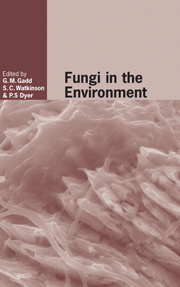Book contents
- Frontmatter
- Contents
- List of contributors
- Preface
- I Imaging and modelling of fungi in the environment
- 1 Imaging complex nutrient dynamics in mycelial networks
- 2 Natural history of the fungal hypha: how Woronin bodies support a multicellular lifestyle
- 3 Environmental sensing and the filamentous fungal lifestyle
- 4 Berkeley Award Lecture: Mathematical modelling of the form and function of fungal mycelia
- II Functional ecology of saprotrophic fungi
- III Mutualistic interactions in the environment
- IV Pathogenic interactions in the environment
- V Environmental population genetics of fungi
- VI Molecular ecology of fungi in the environment
- Index
- References
1 - Imaging complex nutrient dynamics in mycelial networks
from I - Imaging and modelling of fungi in the environment
Published online by Cambridge University Press: 03 November 2009
- Frontmatter
- Contents
- List of contributors
- Preface
- I Imaging and modelling of fungi in the environment
- 1 Imaging complex nutrient dynamics in mycelial networks
- 2 Natural history of the fungal hypha: how Woronin bodies support a multicellular lifestyle
- 3 Environmental sensing and the filamentous fungal lifestyle
- 4 Berkeley Award Lecture: Mathematical modelling of the form and function of fungal mycelia
- II Functional ecology of saprotrophic fungi
- III Mutualistic interactions in the environment
- IV Pathogenic interactions in the environment
- V Environmental population genetics of fungi
- VI Molecular ecology of fungi in the environment
- Index
- References
Summary
Introduction
Basidiomycetes are the major agents of decomposition and nutrient cycling in forest ecosystems, occurring as both saprotrophs and mycorrhizal symbionts (Boddy & Watkinson, 1995; Smith & Read, 1997). The mycelium can scavenge and sequester nutrients from soil, concentrate nutrients from decomposing organic matter, relocate nutrients between different organic resources, and ultimately make nutrients available to plants to maintain primary productivity. Hyphae of both saprotrophic and ectomycorrhizal basidiomycetes that ramify through soil often aggregate to form rapidly extending, persistent, specialized high-conductivity channels termed cords (Rayner et al., 1994, 1999; Boddy, 1999; Watkinson, 1999; Cairney, 2005). These cords form complex networks that can extend for metres or hectares in the natural environment. The distribution of resources is extremely heterogeneous and unpredictable in space and time, and these fungi have developed species-specific strategies to search for new resources and to capitalize on resources landing on their mycelial systems (Chapter 6, this volume). Thus the architecture of the network is not static, but is continuously reconfigured in response to local nutritional or environmental cues, damage or predation, through a combination of growth, branching, fusion or regression (Boddy, 1999; Watkinson, 1999; Chapter 6, this volume). At this stage it is not clear whether specific global mechanisms exist to couple local sensory perception and responses over different length scales specifically to maximize the long-term success of the whole colony, or whether such collective behaviour is an emergent property arising solely from local interactions of individual hyphae.
- Type
- Chapter
- Information
- Fungi in the Environment , pp. 3 - 21Publisher: Cambridge University PressPrint publication year: 2007
References
- 8
- Cited by

